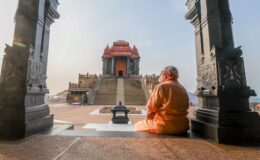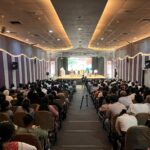BJP’S JOURNEY TO SCALE NEW HEIGHTS HAS BEGUN
- By : Anirban Ganguly
- Category : Articles
Observers and political practitioners have spoken of the organisational restructuring of the BJP as a challenge that needs to be addressed. But the party has already initiated the process ever since Amit Shah took over
While inaugurating the second BJP State library named after the Jana Sangh stalwart and social reformer Nanaji Deshmukh, in Jammu on April 30, Bharatiya Janata Party (BJP) president Amit Shah exhorted workers to further cultivate the habit of reading and of reflecting. Shah referred to the Manthan series, the journal once brought out by Deendayal Research Institute (DRI) which over the years emerged as the focal point for ideological thought-creation and articulation for a large number of workers in the Bharatiya Jana Sangh (BJS), the BJP and the Rashtriya Swayamsevak Sangh (RSS).
The Manthan had succeeded in generating a counter discourse and in carving out a distinct space for itself in the predominantly Left infested intellectual climate of the 1970s-80s and 90s. Shah urged the workers of the party to read the old issues of the now defunct journal, for in its pages was to be still found the ideological nourishment that is imperative for any serious political movement.
Often, in course of his conversations, while discussing the modalities of organising active libraries for the BJP State office across the country, Shah would recall his early days and refer to his subscription of the Manthan when he had just begun his journey in student activism and then in politics. “I would eagerly wait for the Manthan every month”, he would say “and if there was a delay, I would repeatedly enquire, whether it had been despatched at all, this was the kind of intellectual thirst that the journal had generated in me.”
Shah saw the journal as the fountain of our ideological thought and articulation, “it expressed in such cogent and powerful language and arguments our ideological positions and points, which was at once inspiring and thought-provoking, that if one read the articles seriously one could gradually internalise the dimensions of our entire ideological base.”
In fact it was due to his push and his insistence that we dig out the old issues of the journal, dust them off the shelves and make them available to a larger readership, especially the younger generation, which is now once more feeling an urge to intellectually and ideationally challenge a certain warped narrative and reading of India, that the Manthan issues were collected together and, over a period digitised, and then made available on the BJP’s e-library with open access.
The old issues were salvaged and have now been made available to a global audience, especially to our political workers, intellectuals and scholars, interested in the growth and evolution of the nationalist thought world in India. It is such an approach of his, which makes even the smallest constituent unit of the party feel part of the larger transformative movement. It ensures that a political party becomes much more than an election machinery and retains its distinctness as a vibrant ideological flow.
This is an interesting aspect of Shah’s approach, each time he refers to an activity or initiative within the party which is out of the ordinary, is new or requires impetus and fresh energy he refers to his own days and draws parallels, both inspiring workers and laying a framework of action.
Amit Shah, the booth worker, the election agent, the party vistarak, the Manthan reader, the MLA, the Minister, the national general secretary and eventually the party’s national president are not antithetical, rather they are complementary and symbolise the organic growth of the BJP, in which each worker has a prospect of moving up, of recognition and of repeated opportunities to prove themselves. In fact, Shah’s political trajectory remains a model, a map, a track for the political workers of the party; there is no short-cut, no parachuting, and no resorting to dynastism for one who seriously hopes to have a national mantle and acceptance.
Shah’s message in every booth that he visited in West Bengal, his first stop in the five-State tour that he is has undertaken as a vistarak — a worker with the mission to spread the ideals and the organisation of the party — was to point towards the symbolism of seeing the booth president, the district president, the State president and the national president of the party all together on one stage and pledging themselves to spread and strengthen the party from the roots upwards. He dissolved hierarchy and in a sense, co-equalled himself, with the basic political constituent of the party — the booth worker.
Some observers and political practitioners have spoken of the organisational restructuring of BJP as a challenge that needs to be addressed and faced. These observers have, perhaps, missed the point that the BJP, under Shah has already initiated the process of restructuring ever since Shah took over. The formation of 18 departments with the task and mandate of working on various fronts, Shah’s own relentless and punishing schedule of travel in the last 32 months — he has covered a total of 5,07,177 kilometres till March, which makes it around 524 kilometres daily — to reach out to workers, to enthuse them with a multitude of programmes and activities, his dogged pursuit of the membership and training drive are all indicative of the fact that the BJP has started restructuring itself organisationally.
The only difference being that it is a bottom up restructuring and not a tinkering with posts and positions at the top. Shah himself has now embarked on 95-day tour through the summer, right up to September, to lead this restructuring from the roots and infuse it with a new capacity for political articulation. Shah’s 95-day march is bound to be a regenerative one.
In this grassroots rejuvenation and restructuring a wide cross section is being heard, is being reached out and is being assigned responsibilities through the efforts of the party’s national president himself. It is perhaps for the first time that the national president of a party is himself directing and participating in the grassroots expansion and restructuring of the party.
The symbolism of Shah sitting cross-legged at the Naxalbari booth-workers tin hut, or sipping “doi-ghole” in another’s house and walking the bylanes of Bhowanipore in the excruciating Bengal summer, exuded a fundamental message — that of the BJP seriously altering itself and having turned into a mass party was not static but re-working that base to further widen and democratise it.
Ideological rejuvenation, cadre and workers replenishment, grassroots galvanisation and capacity-building for a contemporary articulation are some of the aims of Shah’s 95-day march to restructure the party. The leap from the peak to scale greater height has taken off.
















